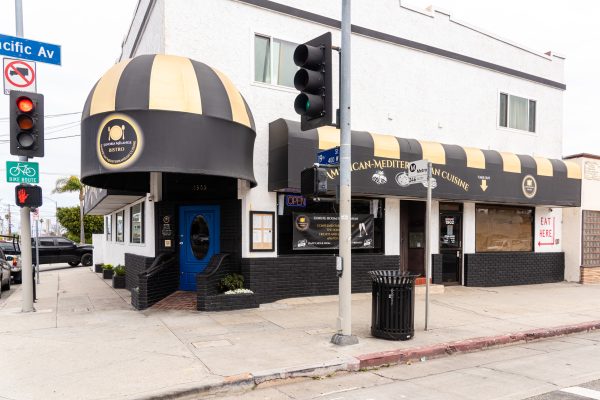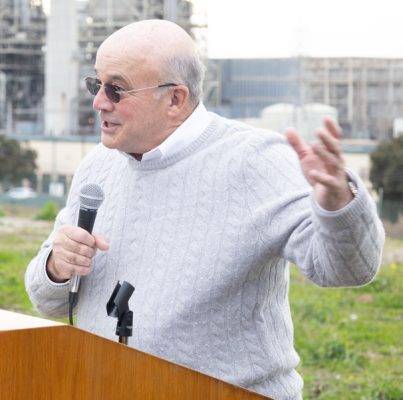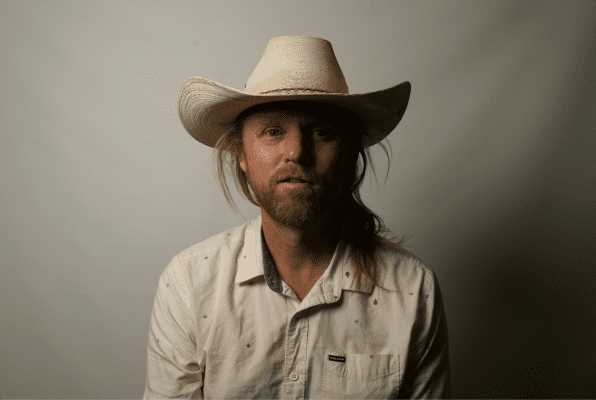Manhattan Beach Middle School’s Maggie Mabery still teaches science by blowing things up, creating stinks and dissecting dead animals. But she also uses technology to help kids teach themselves.

As our lives become ever more entwined with our digital devices, some worry about the impact on childhood development. But Maggie Mabery, who teaches seventh and eighth grade science at Manhattan Beach Middle School, thinks such technology helps kids learn.
“Students are attached to their devices,” she said one day during the recent Thanksgiving holiday. “They’ve been born with these things in their hands. I’m not of that generation, so it’s a good way to make that connection with them. And I think it really does help them learn. We’ve seen it in our classes: our test scores go up due to the use of it. I think they’re just more engaged in the classroom.”
She ought to know. Mabery, 38, whose students have been using iPads in the classroom for three years now, was selected this fall as the Teacher of the Year for the state of California. Now she is competing against teachers from every other state to be the National Teacher of the Year.
Just because her students are using iPads in class doesn’t mean she does fewer of the experiments or demonstrations that are the hallmarks of science classes.
“Science is a hands-on subject,” she said. “Kids should be touching stuff every day, figuring stuff out every day.”
After the holiday, Mabery planned to introduce her students to chemical reactions, which she called “my favorite subject to teach.”
“It’s when we really get to start blowing some stuff up,” she said. “Any time you light something on fire, you’ve got the kids’ attention. When things pop and burn, they love it. And they remember it.”
Mabery planned to do a demonstration called Dragon’s Breath, where she would mix sulfur and iron and then drop it into hydrochloric acid, creating a “stinkbomb.”
“It reacts and lets off, as we all know, the world’s worst smell,” she said. “Do it outside in a quad full of kids—they’ll never forget it.”

Her class recently did the time-honored frog dissection, which Mabery did herself in her middle school science class, and loved. But she had her students film their dissections “like broadcasters and explain what the different organs were.”
She finds that having kids explain the concepts they are learning cements their understanding. She records all of her lectures, and encourages her students to do the same, so they can watch them at home to review.
“I wasn’t a strong math student,” she said. “I would’ve loved to have taped my eighth grade math teacher teaching me quadratic equations and then gone home and watched it 10 times over.”
The next day, she’ll divide the class into those who are comfortable with the concept and those who are still struggling. While taking aside the group that needs more explanation, she’ll have those who get it create their own videos explaining the concept, which they’ll then show to those who are piecing it together.
Students create and publish their own digital books, recording what they learn. They’ll have pictures of themselves doing labs, and can add interactive quizzes at the end of each chapter. They can then go back and review what they learned.
Mabery’s interest in science, especially biology, grew out of a personal struggle: her diagnosis with Type I diabetes at the age of four.
“I wouldn’t be alive if it wasn’t for my mom,” she said. “It was a different disease than it is now. There weren’t glucose tablets or in-home testing. It was a big guessing game.”
She said that her mom, who would give her two injections a day, should have an “automatic nursing degree because of what she had to go through and do.”
Mabery’s mother stayed at home until her daughters were in upper elementary school, when she went back to school. Although she took some nursing classes, she wasn’t able to get a degree due to her family responsiblities.
Because of Mabery’s experience with her disease, she thought she would become a dietician because she wanted to “work with diabetics.”
In college, however, she majored in elementary school education. When she moved to California from the Midwest, she was invited to teach middle school science at Beverly Hills Unified, which she loved. She said she “would never look back.”
“I love being one of the first doors to science for students,” she said.
After teaching in Beverly Hills for a year and half, she was pink-slipped due to budget cuts and began looking for other work. That’s when she was offered her job at Manhattan Beach Middle School, where she’s been teaching for 13 years.
It’s also where she met her future husband, Chad Mabery, a principal at Richardson Middle School in Torrance, who was teaching math at Manhattan Beach Middle School at the time. They met on the first day of school. While they were dating, they kept their relationship a secret. But when they got engaged, they shared the news. Their eighth grade students let them know that they hadn’t fooled anyone.
“They said, ‘We knew you were dating!’” she recalled.
Although it wasn’t her original plan, she loves teaching middle school.
“People look at you say, ‘Middle school, you’re crazy!’” she said. “We love this age. They’re little sponges. They still think their teachers are cool. It’s fun.”
Even though Mabery wasn’t the top student in her high school math classes, her 11th and 12th grade math teacher in Chicago, Mr. Meyers, encouraged her to go into a math- and science-related field.
“He pushed me to say there’s no barriers, you should go into this type of career. He hand wrote my parents a note saying, ‘She may not be the one with the A in class, but sometimes that’s not what you need. You need high energy and enthusiasm,’” she recalled. “And look where it’s gotten me. It’s paid off. I think he was the key to help me get to where I’m at.”

Mabery notes that “being a female in science isn’t the easiest thing,” though that hasn’t stopped her.
“I didn’t feel like I couldn’t be in science classes—that’s just not my personality,” she said. “If someone told me no, I’d ignore them anyway.”
But although her college was focused on science and engineering, she noticed a difference between the tracks for male and female students.
“Sometimes I think, maybe I should’ve been an engineer,” she said. “There was no one pushing me in that. It was mostly males going into that career path.”
She notes that although STEM (Science Technology Engineering Math) has become “a hot topic,” the representation of women and minorities in those fields has lagged behind. She cites the statistic that less than a quarter of STEM-based careers are held by females and minorities, even though those groups comprise two thirds of the U.S. population. With two girls of her own, ages four and six, she said that she hopes that this disparity is “not what we see in the next couple years.”
“I hope it’s not what my daughters see,” she said. “We need to focus on these statistics and create some shifts in schools.”
It seems like her daughters are already following in her footsteps. She said that her older daughter, Emma, “says her favorite thing to do is science and math.”
Mabery said she and her husband are thrilled. For one thing, there’s the job security. But there’s also intangible benefits.
“To build things to help people—it’s very fulfilling,” she said.
Right now, her school is looking at new education guidelines for science classes set by the federal government. The Next Generation Science Standards will be applied by 2018.
Mabery described the shift in science that she sees happening.
“Science is more STEM-focused—a lot more engineering practices, a lot more building, a lot more use of technology,” said Mabery. “I don’t remember building things in my classroom.”
For example, Mabery is getting ready to teach her students about the parts of a cell, which she said she didn’t find particularly interesting when she learned it in middle school.
“I was the kid who was like, who cares?” she said.
So she has told her students to think of the cell as its own world and asked them to consider what they would need if they were to build their own world.
With the shift toward STEM and new technology, Mabery thinks this is the beginning of a new era. “This is the hugest shift that public education has ever seen,” she said.
With her new status as Teacher of the Year, Mabery is becoming an ambassador for that movement. She said she has already been asked to speak at a couple of conferences, including one in San Francisco that will bring together scientists and policy makers.
She will find out in January if she is selected as the National Teacher of the Year. She would get a year-long sabbatical and would visit other countries on behalf of the U.S.
Regardless, she will be flying to Washington, D.C. in April for a ceremony honoring all the states’ top teachers of the year.
“To stand next to the president would be awesome,” she said. “I can’t wait to be in a room with all those amazing teachers.”
She said she feels guilty for being singled out as the top teacher in California.
“I’m representing 300,000 teachers in California,” she said. “That, to me, is insane. All teachers are amazing. I do cool things because I stole it from them.” B









